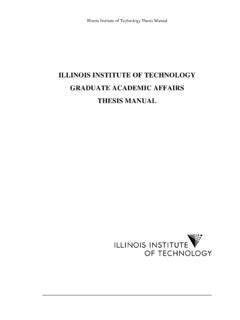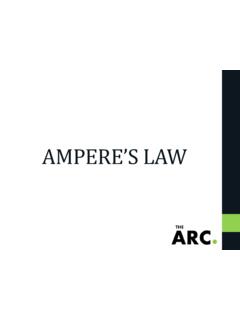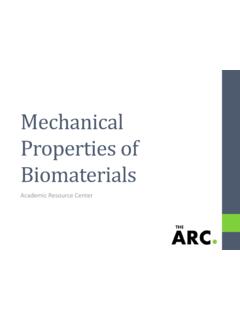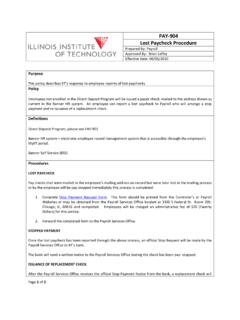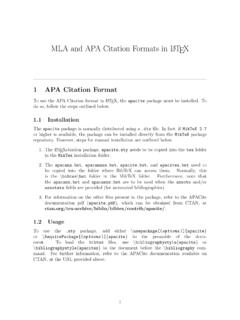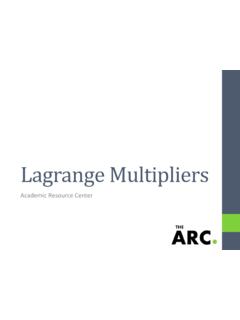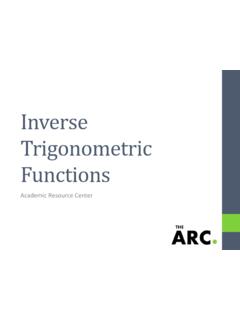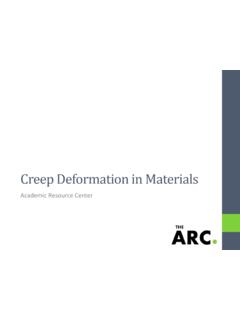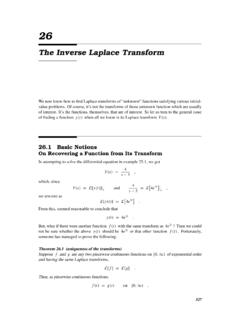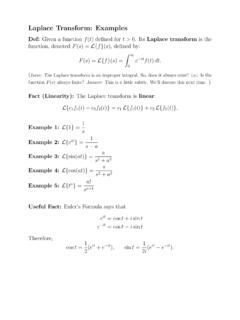Transcription of The Laplace Transform - Illinois Institute of Technology
1 Let f be a function. Its Laplace Transform (function) is denoted by the corresponding capitol letter F. Another notation is Input to the given function f is denoted by t; input to its Laplace Transform F is denoted by s. By default, the domain of the function f=f(t) is the set of all non-negative real numbers. The domain of its Laplace Transform depends on f and can vary from a function to a Laplace TransformL(f).1 Definition of the Laplace Transform The Laplace Transform F=F(s) of a function f=f(t) is defined by The integral is evaluated with respect to t, hence once the limits are substituted, what is left are in terms of s. L(f)(s)=F(s)= 0e tsf(t) : Find the Laplace Transform of the constant functionSolution:f(t)=1,0 t< .F(s)= 0e tsf(t)dt= 0e ts(1)dt= limb + b0e tsdt= limb + e ts s b0provideds = limb + e bs s e0 s = limb + e bs s 1 s 3At this stage we need to recall a limit from Cal 1:Hence, Thus,F(s)=1s,s> this case the domain of the Transform is the set of all positive real x 0ifx + + ifx.
2 Limb + e bs s= 0ifs>0+ ifs< of Transformsf(t)=1,t 0F(s)=1s,s 0f(t)=tn,t 0F(s)=n!sn+1,s 0f(t)=eat,t 0F(s)=1s a,s>af(t) = sin(kt),t 0F(s)=ks2+k2f(t)=cos(kt),t 0F(s)=ss2+k2f(t) = sinh(kt),t 0F(s)=ks2 k2,s>|k|f(t)=cosh(kt),t 0F(s)=ss2 k2,s>|k|5 The Laplace Transform is LinearIf a is a constant and f and g are functions, then For example, by the above property (1)As an another example, by property (2)L(e5t+ cos(3t)) =L(e5t)+L(cos(3t)) =1s 5+ss2+9,s> (3t5)=3L(t5)=3 5!s6 =360s6,s> (af)=aL(f)(1)L(f+g)=L(f)+L(g)(2)6An example where both (1) and (2) are used,L(3t7+ 8) =L(3t7)+L(8) = 3L(t7)+8L(1) = 3 7!s8 +8 1s ,s> Laplace Transform of the product of two functions L(fg) =L(f)L(g).As an example, we determineThe respective domains of the above three transforms are s>0, s>6, and s>12; equivalently, s>12. L(3 +e6t)2=L(3 +e6t)(3 +e6t)=L(9 + 6e6t+e12t)=L(9) +L(6e6t+L(e12t)= 9L(1) + 6L(e6t)+L(e12t)=9s+6s 6+1s Inverse TransformLea f be a function and be its Laplace Transform .)
3 Then, by definition, f is the inverse Transform of F. This is denoted by L(f)=FL 1(F)= an example, from the Laplace Transforms Table, we see thatWritten in the inverse Transform notationL 1 6s2+ 36 = sin(6t).L(sin(6t)) =6s2+ that Hence, for example, L(tn)=n!sn+1. L 1 7!s8 = , by examining the power s8we saw that n= consider Here n+1=11. Hence n=10. Now, we need to make the numerator to be 10!.L 1 5s11 .L 1 5s11 = 5L 1 1s11 =510!L 1 10!s11 =510! Consider , is that of the Laplace transforms of +k2L 1 7s+ 15s2+2 =L 1 7ss2+2 +L 1 15s2+2 = 7L 1 ss2+2 + 15L 1 1s2+2 = 7 cos( 2t)+15 2L 1 2s2+2 = 7 cos( 2t)+15 2sin( 2t)More Examples of Inverse TransformsL 1 7s+ 15s2+2 .The form of the denominator,10 Partial FractionsConsider the rational expressions3s+5s2 3s 10=3s+5(s 5)(s+ 2)The denominator is factored, and the degree of the numerator is at least one less that that of the denominator, in fact, it is exactly one less than the degree of the can, therefore, put the rational expression in partial fractions.
4 This means for constants A and B, 113s+5(s 5)(s+2)=As 5+Bs+ determine A and B, first clear the denominators:3s+5 (s 5)(s+2) (s 5)(s+2)=A (s 5) (s 5)(s+2)+B (s+2)(s 5) (s+2).Thus we have the polynomial equality:3s+5=A(s+2)+B(s 5)=(A+B)s+2A comparing the coefficients of s and constant coefficients, we get two equations in A and +B=32A 5B=5we have the decomposition12We can solve for A and B by using Cramer s ruleA=det 315 5 det 112 5 ,andB=det 1325 det 112 5 Now by the definition of the determinant, det abcd =ad , A=207,andB= can now determine the inverse transformL 1 3s+5(s 5)(s+ 2) =L 1 As 5+Bs+2 =AL 1 1s 5 +BL 1 1s+2 =207e5t+17e could also have been directly determined by using a formula from your Table of Laplace Transforms from the text. This inverse Transform will be used in slide #19 to solve an in partial fractions. 3s+4(s 2)(s2+7)Since s2 +7 is a quadratic, when it is put in partial fractions, its numerator must be the general polynomial of degree one.
5 3s+4(s 2)(s2+7)=As 2+Bs+Ds2+73s+4 (s 2)(s2+7) (s 2)(s2+7)=A s 2 (s 2)(s2+7)+Bs+D s2+7(s 2) (s2+7)Hence, we have the equality of polynomials:Comparing the coefficients of s2, s, and constant coefficients, A+B=0, 2B+D=3,and7A 2D= Fractions: More Examples 3s+4=A(s2+7)+(Bs+D)(s 2)=(A+B)s2+( 2B+D)s+7A 2D15 From the first equation, we get that B=-A. Sub in the second, to get2A+D=3(1)7A 2D=4(2)Then,Hence, A=det 314 2 det 217 2 = 10 11,andD=det 2374 det 217 2 = 13 ,B= A= 1011,D= of DerivativesGiven a function y=y(t), the Transform of its derivative y can be expressed in terms of the Laplace Transform of y:L(y )=sL(y) y(0).The corresponding formula for y can be obtained by replacing y by y (equation 1 below).L(y ) =sL(y ) y (0)(1)=s(sL(y) y(0)) y (0)(2)=s2L(y) sy(0) y (0).(3)Hence, L(y )=s2L(y) sy(0) y (0).17 Solving IVP with Laplace TransformsSolve the IVPy 5y= e 2t,y(0)= the Laplace Transform of both sides, L(y 5y)=L( e 2t)(1)L(y ) 5L(y)= 1s+2(2)sL(y) y(0) 5L(y)= 1s+2(3)(s 5)L(y) 3= 1s+2(4)(s 5)L(y)= 1s+2+3=3s+5s+2(5)L(y)=3s+5(s 5)(s+ 2)(6)Example 1:Solution:18 Hence, by the definition of the inverse Transform , y=L 1 3s+5(s 5)(s+ 2) =207e5t+17e above inverse Transform was found in slide # the IVP: Example 2:y +7y= 10e2t,y(0) = 0,y (0) = :Taking the Laplace Transform of both sides,L(y )+7L(y) = 10L(e2t)30s2L(y) sy(0) y (0)+7L(y)=10s 219(s2+7)L(y) 3=10s 2(s2+7)L(y)=3+10s 2=3(s 2)+10s 2L(y)=3s+4(s 2)(s2+7)Then, y=L 1 3s+4(s 2)(s2+7).
6 Partial fraction decomposition in slide # 15 and 16, y=1011L 1 1s 2 1011L 1 ss2+7 +1311L 1 1s2+7 .y=1011e2t 1011cos( 7t)+1311 7sin( 7t).Whence, Now using the20 Example 1L(cos(kt))=ss2+ findL(eatcos(kt))we replace s by s-a. Hence,L(eatcos(kt))=s a(s a)2+ inverse version is also useful: The corresponding sine version isL 1 k(s a)2+k2 =eatsin(kt).Notice matching s-a on the numerator and :LetL(y(t))=Y(s).ThenL(eaty(t))=Y(s a).L 1 s a(s a)2+k2 =eatcos(kt).21 Find:L 1 4s+1s2+10s+34 .Here the denominator does not factor over the reals. Hence complete the + 10s+ 34 =s2+ 10s+ 25 25 + 34 = (s+ 5)2+ 1 4s+1s2+10s+34 =L 1 4s+1(s+5)2+9 =L 1 4(s+5) 20+1(s+5)2+9 =L 1 4(s+5) 19(s+5)2+9 =4L 1 (s+5)(s+5)2+9 19L 1 1(s+5)2+9 =4e 5tcos(3t) 193L 1 3(s+5)2+9 =4e 5tcos(3t) 193e 5tsin(3t).this s must now be made into (s+5). 22 Example 1:NowL(eat)=1s a,s = other words,L 1 1(s a)2 = : LetL(f(t))=F(s).ThenL(tf(t))= F (s).Hence,L(teat)= 1s a =1(s a)2,s = 2:FindSolution:NowThen by the Lemma, f(t)=L 1(ln s+2s 3 ).
7 L(f(t))=ln s+2s 3 .Next SlideL(tf(t))= ln s+2s 3 = (ln(s+2) ln(s 3)) 23L(tf(t)) = (1s+2 1s 3)=1s 3 1s+ ,tf(t)=L 1(1s 3) L 1(1s+2)=e3t e ,f(t)=e3t e 2tt,t> Function and Piece-wise Defined FunctionsLet a 0. The Heaviside unit function U(t a) is defined byU(t a)= 1 ift a0 if 0 t< unit function can be used to express piecewise f be the piecewise defined functionNow consider the function If 0 t<8, then U(t 8) = 0. ThenIf t 8, then U(t 8) = 1. 4+(6 4)U(t 8)=4+6 4= , we see that f(t)=4+2U(t 8).f(t)= 4if 0 t<86ift 1:4+(6 4)U(t 8).4+(6 4)U(t 8)= the piecewise defined functionf(t)= tif 0 t<2t2if 2 t<6t3if 6 can expressfin terms of unit (t)=t+(t2 t)U(t 2) + (t3 t2)U(t 6).Example 2:Notice how the coefficients of the unit functions are related to the outputs by the piece-wise defined a Functionay=f(t)y=g(t)The graph of g has been obtained by truncating that of (t)= 0if 0 t<af(t)ift (t)=f(t)U(t a).28 Truncating a Functionay=f(t)y=g(t)The graph of g has been obtained by truncating that of (t)=f(t)U(t a) f(t)U(t b).
8 G(t)= 0if 0 t<af(t)ifa t<b0ifb and Truncating a Functionay=f(t)y=g(t)The graph of g has been obtained translating the graph of f by c units to the right and then truncating by=gy=gcy=f(t-c)g(t)= 0if 0 t<af(t c)ifa t<b0ifb (a)a= 0if 0 t<af(t a)ifa (t)=f(t a)U(t a)Example 1:FindL(sin(t 2)U(t 2)).Solution:Here a is 2 and f(t 2) = sin(t 2).Weneed f(t) to determine F(s). We can get it from the formula for f(t 2) by replacing t by t+ (t+2 2) = sin(t+2 2), , f(t) = sin(t).Hence,L(sin(t 2)U(t 2)) =F(s)e 2s=1s2+4e 1 Leta 0andL(f(t))=F(s).ThenL(f(t a)U(t a))=e asF(s).31 Example 2:Determine L(t2U(t 2)).Solution:Recall the formulaL(f(t a)U(t a))=e asF(s),whereF(s)=L(f).In this case, a=2, andf(t a)=f(t 2)= obtain F(s), we first need f(t). In order to do that replace t in the formula for f(t 2) by t+2. f(t 2) =t2f(t+2 2) = (t+ 2)2=t2+4t+4f(t) =t2+4t+4F(s)=L(t2)+4L(t)+4L(1)=2s3+4s2+4s,s> (t2U(t 2))= 2s3+4s2+4s e 2s,s> 3:DetermineL sin( 2t)U(t 3).
9 Now to obtain , Solution:Comparing U(t a)Hence,f(t 3) = sin( 2t).f(t)by in the formula for f(t 3).t+3 Then, f(t+3 3) = sin( 2(t+ 3)) = sin( 2t+ 23)).Now an elementary trig identity statessin(3 2+ )= cos( ).Whence, f(t)= cos( 2t).ThusF(s)= ss2+ sin( 2t)U(t 3) =e 3sss2+ (t 3)with,we get a= t33 LetL 1(e asF(s))=U(t a)f(t a).L 1(F(s))=f(t).ThenExample 1:L 1 ss2+4 =cos(2t).HenceL 1 ss2+4e 7s =cos(2(t 7))U(t 7).The presence of e 7scaused two changes to cos(2t):the input t was replaced by t 7and thencos(2(t 7))was multiplied by U(t 7).Recall34 Example 2:Determine L 1 e 7s(s 5)2+4 .First consider the inverse without the factor e 1 1(s 5)2+4 =e5tsin(2t).Thus, L 1 e 7s(s 5)2+4 = e5(t 7)sin(2(t 7))U(t 7).Replace t by t f and g be functions. The convolution of f with g is defined by f g(t)= t0f( )g(t )d .Thus in a convolution integral, in general, you will see a factor (the t in the output by f replaced by ), and a factor (the t in the output by g replaced by ).
10 T sin 3t e5t= t0sin(3 ) e5(t ) d .the factorthe factor t t 36 Example 1:Let and f(t)=t2g(t)=2t+ :f g(t)= t0f(t)g(t )d = t0 2(2(t )+3)d .= t0 2(2t+3 )d =(2t+3) t0 2d t0 3d =(2t+3) 33 t0 44 t0=(2t+3)t33 t44=5t412+ 2:Express the following integral as a convolution. t0 3cos(t )d . factor t factorReplace byttoget the first factorof the convolutionReplacet byttoget the second factorof the convolution t0 3cos(t )d =t3 cos(t)38 Example 3: t0e2(t ) 3d =t3 4:In the following example t factor is is because the second factor of the convolution was a constant. t0 3d =t3 5: t0et 2 d = t0e et d =e t see that the convolutionis not the constant e t etHere is an alternative view of the same integral t0et 2 d = t0ete 2 d =et t0e 2 d =et(e 2t 1).However, in general f(g h) =(fg) (fh).function Transform of ConvolutionsThe Laplace Transform of the product of two functionsis not equal to the product of the two transforms:L(fg) =L(f)L(g).
